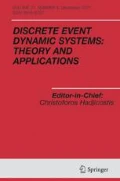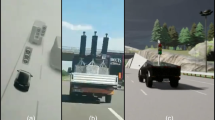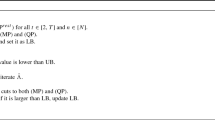Abstract
We consider a Petri Net model of the plant. The observation is given by a subset of transitions whose occurrence is always and immediately sensed by a monitoring agent. Other transitions not in this subset are silent (unobservable). Classical on-line monitoring techniques, which are based on the estimation of the current state of the plant and the detection of the occurrence of undesirable events (faults), are not suitable for models of large systems due to high spatial complexity (exponential in the size of the entire model). In this paper we propose a method based on the explanation of plant observation. A legal trace minimally explains the observation if it includes all unobservable transitions whose firing is needed to enable the observed transitions. To do so, starting from an observable transition, using backward search techniques, a set of minimal explanations is derived, which are sufficient for detecting whether a fault event must have occurred for sure in the plant or not. The technique also allows production of a set of basis markings for the estimation of the current state of the plant. The set of all possible current markings can then be characterized as the unobservable reach of these basis markings. The computational complexity of the algorithm depends on the size of the largest connected subnet which includes only unobservable transitions. This allows monitoring of plants of any size in which there is no large unobservable subnet. We also illustrate the applicability of the method for the monitoring of a class of infinite state systems, unbounded Petri Nets with unobservable trap circuits, and we show how this can be useful for distributed implementations.





Similar content being viewed by others
References
Abdulla PA, Iyer SP, Nylen A (2000) On unfolding unbounded Petri Nets. Computer Aided Verification, LNCS, vol 1855. Springer
Baroni P, Lamperti G (1999) Diagnosis of large active systems. Artif Intell 101(1):135–183
Benvensite A, Fabre E, Haar S, Jard C (2003) Diagnosis of asynchronous discrete event systems, a net unfolding approach. IEEE Trans Automat Contr 48(5):182–187
Boel RK, Jiroveanu G (2003) Petri Nets model-based fault section detection and diagnosis in electrical power networks. In: Proceedings of the 6th IPEC conference, Singapore
Boel RK, Jiroveanu G (2004) Distributed contextual diagnosis for very large systems. In: Proceedings of the 7th workshop on discrete event systems (WODES’04), Reims, France
Boufaied A, Subias A, Combacau M (2002) Chronicle modeling by Petri Nets for distributed detection of process failures. In: Proceedings of the IEEE conference on systems, management and cybernetics, Hammamet, Tunisie
Cardoso J, Kunzle LA, Valette R (1995) Petri Net based reasoning for the diagnosis of dynamic discrete event systems. In: Proceedings of the 6th international fuzzy systems association world congress, July, pp 333–336
Cordier M-O, Grastien A (2007) Exploiting independence in a decentralised and incremental approach of diagnosis. In: Proceedings of IJCAI 2007, Hyderabad, India, pp 292–297
Corona D, Giua A, Seatzu C (2004) Marking estimation of Petri Nets with silent transitions. In: Proceedings of IEEE 43rd int. conf. on decision and control, Atlantis, The Bahamas, December
Delzanno G, Raskin J-F, Van Begin L (2004) Covering sharing trees: a compact data structure for parameterized verification. Softw Tools Technol Trans 5(2):268–297
Dickson LE (1913) Finiteness of the odd perfect and primitive abundant numbers with n distinct prime factors. Am J Math 35:413–422
Fabre E, Benvensite A, Haar S, Jard C (2005) Distributed monitoring of concurrent and asynchronous systems. J Discrete Event Dyn Syst 15(1):33–84, March
Finkel A, Raskin J-F, Samuelidis M, Van Begin L (2002) Monotonic extensions of Petri Nets: forward and backward search revisited. Electron Notes Theoret Comput Sci 68(6)
Genc S, Lafortune S (2003) Distributed diagnosis for DES using Petri Nets. In: Proceedings of the conference on applications and theory of Petri Nets (ATPN’03), Eindhoven, The Nederlands
Giua A, Seatzu C (2005) Fault detection for discrete event systems using Petri Nets with unobservable transitions. In: Proceedings of the conference on decision and control (CDC-ECC’05), Sevilla, Spain, December, pp 6323–6328
Hadjicostis CN, Verghese GC (1999) Monitoring discrete event systems using Petri Net embeddings. Application and theory of Petri Nets—LNCS, vol 1639. Springer, pp 188–207
Hadjicostis CN, Verghese G (2000) Power systems monitoring based on relay and circuit breaker. In: IEE proceedings on generation, transmission and distribution, vol 147, pp 299–303
Haar S, Benveniste A, Fabre E, Jard C (2003) Partial order diagnosability of discrete event systems using Petri Net unfolding. In: Proceedings of the 42th IEEE conference on decision and control (CDC’03), HI, USA
Holloway LE, Ashley J (2002) Diagnosis of condition systems using causal structure. In: Proceedings of the American control conference, Alaska, USA
Holloway LE, Chand S (1996) Distributed fault monitoring in manufacturing systems using concurrent discrete-event observations. Integr Comput-Aided Eng 3:244–254
Jiang S, Kumar R (2004) Failure diagnosis of discrete event systems with linear-time temporal logic specifications. IEEE Trans Automat Control 49
Jiroveanu G (2006) Fault diagnosis for large Petri Nets. PhD thesis, Ghent University, Gent, Belgium
Jiroveanu G, Boel RK (2004) Contextual analysis of Petri Nets for distributed applications. In: Proceedings of MTNS’04 conference, Leuven, Belgium
Kurine J, Koutsoukos X, Su R, Wonham WM (2002) Distributed diagnosis for qualitative systems. In: Proceedings of the workshop on discrete event systems (WODES’02), Zaragoza, Spain
Lin F (1994) Diagnosability of discrete event systems and its application. Discret Event Dyn Syst 4:197–212
Mancel C, Lopez P, Riviére N, Valette R (2002) Relationships between Petri Nets and constraint graphs: application to manufacturing. In: Proceedings of the 15th IFAC triennial world congress
Marchand H, Boivineau O, Lafortune S (2000) Optimal control of discrete event systems under partial observation. Technical report, INRIA Rennes
Murata T (1989) Petri Nets: properties, analysis and applications. Proceedings IEEE 77(4):541–580, April
Nielsen JL, Andersen HR, Hulgaard H, Behrmann G, Kristoffersen K, Larsen KG (1998) Verification of large state/event systems using compositionality and dependency analysis. In: Proceedings of the international conference on tools and algorithms for construction and analysis, pp 201–216
Ozveren CM, Willsky AS (1990) Observability of discrete event systems. IEEE Trans Automat Control 35(7):797–806
Pencolé Y, Cordier M-O, Rozé, L (2001) Incremental decentralized diagnosis approach for the supervision of a telecommunication network. In: Proceedings of the workshop on principles of diagnosis (DX’01), Italy
Portinale L, Anglano C (1994) B–W analysis: a backward reachability analysis for diagnostic problem solving suitable to parallel implementation. In: Proceedings of the 15th int. conference on application and theory of Petri Nets, LNCS, vol 815, Zaragoza, Spain, pp 39–58
Sampath M, Sengupta R, Lafortune S, Sinnamohideen S, Teneketzis D (1995) Diagnosability of discrete event systems. IEEE Trans Automat Control 40(9):1555–1575
Srinivasan VS, Jafari MA (1994) Fault detection/monitoring using timed Petri Nets. IEEE Trans Syst Manag Cybern 23(4):1155–1162
Yang CL, Onamoto H, Yokoyama A, Sekine Y (1992) Expert system for fault section estimation of power systems using time sequence information. Int J Electric Power Energy Syst 14(2/3): 225–232
Zad SH, Kwong RH, Wonham WM (2003) Fault diagnosis in discrete-event systems: framework and model reduction. IEEE Trans Automat Control 48(7)
Acknowledgements
This research was partially sponsored by the Researcher Found of Ghent University (BOF) and by the Belgian Program on Inter-university Poles of Attraction (IAP) initiated by the Belgium State, Prime Minister’s Office for Science, Technology and Culture. The scientific responsibility for the results of this paper remains with the authors. The first author was also supported by a Doctoral Fellowship from the Research Council of Ghent University (BOF doctoraatbeurs).
Author information
Authors and Affiliations
Corresponding author
Rights and permissions
About this article
Cite this article
Jiroveanu, G., Boel, R.K. & Bordbar, B. On-Line Monitoring of Large Petri Net Models Under Partial Observation. Discrete Event Dyn Syst 18, 323–354 (2008). https://doi.org/10.1007/s10626-007-0036-x
Received:
Accepted:
Published:
Issue Date:
DOI: https://doi.org/10.1007/s10626-007-0036-x




